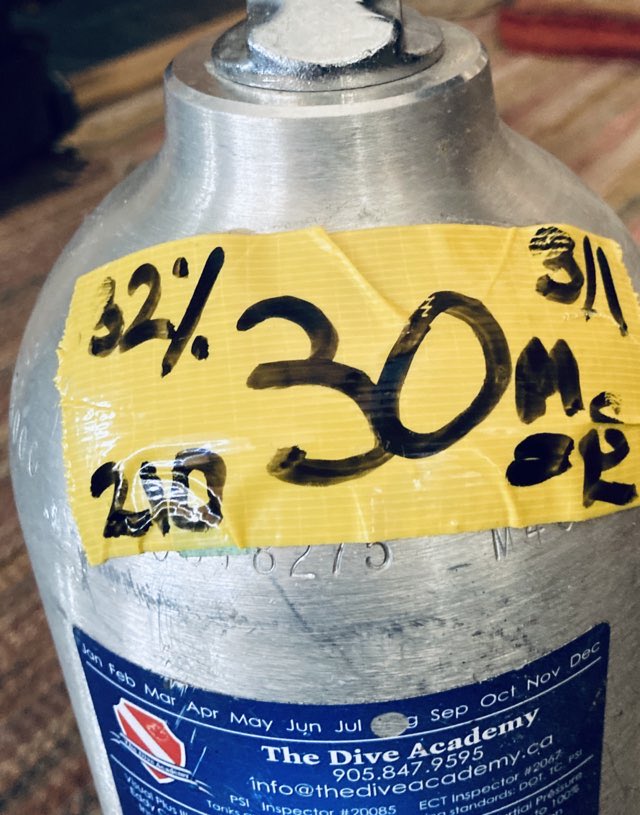BUT ITS JOB IS KEEPING DIVERS SAFE
When it’s time to fill cylinders to go diving, Nitrox is king. Oxygen Enriched Air, nitrox, EANx, whatever we want to call it, is totally mainstream and the default diving gas for SCUBA divers around the globe. Odd to think that when first introduced the established training agencies (the biggest ones), campaigned against nitrox suggesting it was way too complicated for the average diver. Promoting its use, they said, would result in dead divers stacked like cordwood at the water’s edge. WRONG!
Luckily, folks like Dick Rutkowski (then the Deputy Diving Officer at NOAA), and newly formed “technical” training agencies kept pushing it as a great alternative to compressed air, and after a lot of heavy breathing (forgive the pun)… well, here we are. Nitrox is quite normal and standard fare, and certainly not technical at all. Some divers even opt to use it during their basic OW20 training.
The primary concerns were (and remain) being sure not to breathe it beyond its maximum recommended depth (a potential trigger for Central Nervous System (CNS) oxygen toxicity), and the spectre of creating a raging fire by using an oxygen-enriched gas in equipment not prepared and fitted with components compatible with increased O2.
Of course, the fix is proper training (see RAID’s Nitrox Diver Course). The rules are simple and now most of the world’s SCUBA training agencies — certainly all of the Big Seven — offer similar diver-level programs based on the original guidelines published in the late 1980s by NOAA (National Oceanographic and Atmospheric Agency).
One of the key points to staying safe, and the topic for today’s blog post at Dive RAID International is labelling. An often-asked question from students is what do we suggest divers put on their nitrox tanks to help keep them safe? The answer is quite simple, but isn’t dogmatic.
And to be clear, when we mention a labels and labelling, we don’t mean the ubiquitous yellow and green tank stickers popular at dive shops and resorts. These are essential when scuba cylinders, some filled with Nitrox and others with regular air fills, are being loaded onto a charter boat.
Nope, we mean the contents stickers (usually a piece of duct tape stuck to the tank’s shoulder), that show exactly what’s in the tank, who filled it, when, and how much.
Let’s deconstruct that a little.
I don’t know how you feel about it, but I will not get into the water with a tank that hasn’t been analysed. and correctly labelled. You may feel that’s a little over-the-top, especially if divers in your area are still diving mostly air. However, CNS oxygen toxicity, is the bête noire of nitrox diving. We should all be mindful of its potential to ruin the day. But it’s the easiest unwanted nasty to avoid. We just have to follow safe diving practices, which include monitoring the oxygen exposure limits and ensuring proper gas mixtures are used, but most of all, ‘always know what gas you are breathing!”

And the secret there is to alway analyse your gas. Always. Before every dive. And when you have done that, label it.
There are several ways that people swear are the ONLY way to label a nitrox cylinder, and they all have their merits. However, the one core and critical thing is that the MOD (maximum operating depth) is clearly visible on the surface and once the tank is being used in the water.
What I was taught back by my cave IT was simple. A piece of tape with the MOD big and bold in the middle. The oxygen percentage top left, date of analysis top right, fill pressure bottom left, and initials of who worked the analyser bottom right.
As you can see from the picture of an actual bailout cylinder on the left, a ‘working ‘ label does not have to presented as a piece of art, but it does have to be functional and informative. From this label, we know the tank contains a 32 percent nitrox, which was analysed on March first. The label also ‘tells’ us, this tank is full (it’s at 210 bar according to the label), and the person who did the analysis has the initials SL.
As mentioned, there are several ways to mark a nitrox tank. This is one of them.
POSTSCRIPT: Several visitors have ask why the example above shows a fill of EAN32 but a depth rating that results in an oxygen partial pressure pressure of 1.28 bar (1.3 rounded for safety). Although the popular convention is to accept an MOD (maximum operating depth) of 1.6 for technical diving, and a TOD (target operating depth) of 1.4 bar of oxygen for recreational diving, advanced users tend to operate within a ‘personal’ limit which is almost always lower. This particular bailout bottle was for use on a CCR cave dive where dose (the combination of PO2 AND exposure time) and multi-day diving were considerations. Sorry for any confusion!
Thanks for your attention.

